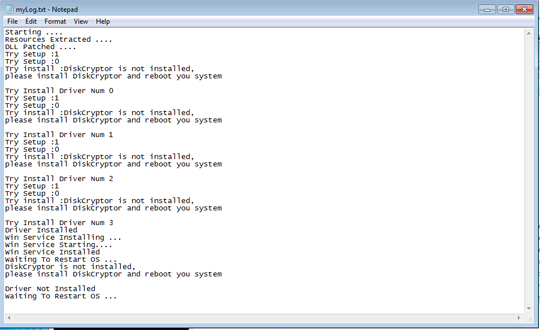Ransom.Win32.MCRYPT.THABAOAH
Trojan-Ransom.MSIL.Agent.abl(Kaspersky); Trojan:Win32/Occamy.C(Microsoft); Ransom.Wannacry(Symantec)
Windows

Threat Type:
Ransomware
Destructiveness:
No
Encrypted:

In the wild::
Yes
OVERVIEW
TECHNICAL DETAILS
Instalación
Agrega los procesos siguientes:
- "cmd.exe" /C ping 127.0.0.1 -n 5& Del → executes this command if "%System%\drivers\dcrypt.sys" is not found in the system
- "%Public%\dcinst.exe" -install → will not execute properly since it is not a parameter by nature of the file
- "%Public%\dcinst.exe" -setup → installs "dcrypt.sys" as a service into the system
- "%Public%\dccon.exe" -install → will not execute properly since it is not a parameter by nature of the file
- "shutdown.exe" /r /f /t 03 → shuts down the system after attempting to install the driver, dcrypt.sys into the system
- "%Public%\dccon.exe" -enum → enumerates the following information from the system.
- Drive Letter
- Drive Name
- Size
- Bootable (Y/N)
- Bootloader
(Nota: %System% es la carpeta del sistema de Windows, que en el caso de Windows 98 y ME suele estar en C:\Windows\System, en el caso de Windows NT y 2000 en C:\WINNT\System32 y en el caso de Windows 2000(32-bit), XP, Server 2003(32-bit), Vista, 7, 8, 8.1, 2008(64-bit), 2012(64bit) y 10(64-bit) en C:\Windows\System32).
)Técnica de inicio automático
Elimina las siguientes claves de registro asociadas a aplicaciones antivirus y de seguridad:
HKEY_LOCAL_MACHINE\SYSTEM\CurrentControlSet\
services\dcrypt\Instances\
dcrypt
Altitude = 87150
HKEY_LOCAL_MACHINE\SYSTEM\CurrentControlSet\
services\dcrypt\Instances\
dcrypt
Flags = 0
HKEY_LOCAL_MACHINE\SYSTEM\CurrentControlSet\
services\dcrypt\Instances
DefaultInstance = "dcrypt"
HKEY_LOCAL_MACHINE\SYSTEM\CurrentControlSet\
services\dcrypt\config
Flags = "1408"
HKEY_LOCAL_MACHINE\SYSTEM\CurrentControlSet\
services\dcrypt\config
Hotkeys = "\x00\x00\x00\x00\x00\x00\x00\x00\x00\x00\x00\x00\x00\x00\x00\x00"
HKEY_LOCAL_MACHINE\SYSTEM\CurrentControlSet\
services\dcrypt\config
sysBuild = "846"
HKEY_LOCAL_MACHINE\SYSTEM\CurrentControlSet\
Services\myCryptoraphyService
DisplayName = "myCryptoraphyService"
HKEY_LOCAL_MACHINE\SYSTEM\CurrentControlSet\
Services\myCryptoraphyService
ImagePath = "{malware path and file name}.exe"
HKEY_LOCAL_MACHINE\SYSTEM\CurrentControlSet\
Services\myCryptoraphyService
Start = "SERVICE_AUTO_START"
HKEY_LOCAL_MACHINE\SYSTEM\CurrentControlSet\
Services\dcrypt
DisplayName = "DiskCryptor driver"
HKEY_LOCAL_MACHINE\SYSTEM\CurrentControlSet\
Services\dcrypt
ImagePath = "%System%\drivers\dcrypt.sys"
HKEY_LOCAL_MACHINE\SYSTEM\CurrentControlSet\
Services\dcrypt
Start = "SERVICE_BOOT_START"
Otras modificaciones del sistema
Agrega las siguientes entradas de registro:
HKEY_LOCAL_MACHINE\SYSTEM\ControlSet001\
services\dcrypt\Instances\
dcrypt
Altitude = "87150"
HKEY_LOCAL_MACHINE\SYSTEM\ControlSet001\
services\dcrypt\Instances\
dcrypt
Flags = "0"
Rutina de infiltración
Infiltra los archivos siguientes:
- %Public%\myLog.txt → contains the log of the malware process upon execution. A sample log is seen from the image:

- %Public%\dccon.exe → used to check information and perform other functions in a system's volume information
- %Public%\dcinst.exe → Contains the configuration and setup of the malware
- %Public%\dcrypt.sys
- %Public%\myConf.txt → contains the input argument/parameter that was set by the victim
- %System%\drivers\dcrypt.sys
- %Public%\dcapi.dll → contains all the calling functions that dcinst.exe and dccon.exe uses
SOLUTION
Step 1
Los usuarios de Windows ME y XP, antes de llevar a cabo cualquier exploración, deben comprobar que tienen desactivada la opción Restaurar sistema para permitir la exploración completa del equipo.
Step 2
Reiniciar en modo seguro
Step 3
Identificar y terminar los archivos detectados como Ransom.Win32.MCRYPT.THABAOAH
- Para los usuarios de Windows 98 y ME, puede que el Administrador de tareas de Windows no muestre todos los procesos en ejecución. En tal caso, utilice un visor de procesos de una tercera parte (preferiblemente, el Explorador de procesos) para terminar el archivo de malware/grayware/spyware. Puede descargar la herramienta en cuestión aquí.
- Si el archivo detectado aparece en el Administrador de tareas o en el Explorador de procesos, pero no puede eliminarlo, reinicie el equipo en modo seguro. Para ello, consulte este enlace para obtener todos los pasos necesarios.
- Si el archivo detectado no se muestra en el Administrador de tareas o el Explorador de procesos, prosiga con los pasos que se indican a continuación.
Step 4
Buscar y eliminar estos archivos
- %Public%\myLog.txt
- %Public%\dccon.exe
- %Public%\dcinst.exe
- %Public%\dcrypt.sys
- %Public%\myConf.txt
- %System%\drivers\dcrypt.sys
- %Public%\dcapi.dll
- %Public%\myLog.txt
- %Public%\dccon.exe
- %Public%\dcinst.exe
- %Public%\dcrypt.sys
- %Public%\myConf.txt
- %System%\drivers\dcrypt.sys
- %Public%\dcapi.dll
Step 5
Eliminar esta clave del Registro
Importante: si modifica el Registro de Windows incorrectamente, podría hacer que el sistema funcione mal de manera irreversible. Lleve a cabo este paso solo si sabe cómo hacerlo o si puede contar con ayuda de su administrador del sistema. De lo contrario, lea este artículo de Microsoft antes de modificar el Registro del equipo.
HKEY_LOCAL_MACHINE\SYSTEM\ControlSet001\services\dcryptStep 6
Reinicie en modo normal y explore el equipo con su producto de Trend Micro para buscar los archivos identificados como Ransom.Win32.MCRYPT.THABAOAH En caso de que el producto de Trend Micro ya haya limpiado, eliminado o puesto en cuarentena los archivos detectados, no serán necesarios más pasos. Puede optar simplemente por eliminar los archivos en cuarentena. Consulte esta página de Base de conocimientos para obtener más información.
Did this description help? Tell us how we did.

